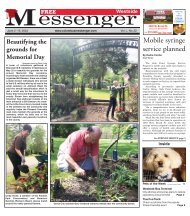You also want an ePaper? Increase the reach of your titles
YUMPU automatically turns print PDFs into web optimized ePapers that Google loves.
www.madisonmessengernews.com<br />
opinion<br />
<strong>September</strong> 13, <strong>2020</strong> - MADISON MESSENGER - Page 5<br />
Call to action: Connecting kids with nature<br />
Each day, our youth will likely<br />
spend a meager four to seven minutes<br />
playing outside. This number<br />
becomes concerning when a recent<br />
survey suggests children are<br />
spending more than seven hours a<br />
day in front of a screen. This increase<br />
in screen time is associated<br />
with an overall decrease in psychological<br />
well-being and physical fitness.<br />
Though this information is<br />
personally gut wrenching, it isn’t<br />
the motivation behind my cry for<br />
help. I am driven by firsthand experiences<br />
shared with my students<br />
in a rural high school outside of<br />
Columbus, Ohio.<br />
I am fortunate to work in a<br />
school district that has plenty of<br />
greenspace and ample opportunities<br />
to venture outdoors. However,<br />
my students are becoming more<br />
and more reluctant to join me as I<br />
attempt to hold class outside. The<br />
outdoors are becoming a foreign<br />
world. What I rely on as a source of<br />
imagination, creation and calm is<br />
a source of discomfort for my students.<br />
I can’t help but question the<br />
future of our planet and the generation we<br />
will be leaving it to. Nevertheless, I choose<br />
to revel in the hope that we aren’t too far<br />
gone.<br />
In the fall of 2019, I created an after<br />
school nature club to facilitate the bond between<br />
nature and adolescents. The students<br />
met one hour a week for 18 weeks. During<br />
this time, students made an effort to explore<br />
school grounds, restore native vegetation,<br />
identify local species and simply disconnect.<br />
Astonishingly, this disconnection allowed<br />
my students to become attuned to the natural<br />
world and experience the interconnectedness<br />
amongst all living things. After just<br />
one semester, students expressed their increased<br />
empathy for the natural world and<br />
their newfound desire to protect it. I observed<br />
that students’ mental health and<br />
physical fitness had improved and they expressed<br />
feeling calmer and happier.<br />
Studies suggest that children who are<br />
more connected to the natural world are<br />
more likely to develop pro-environmental<br />
behaviors as an adult. So, how do we, as<br />
parents, guardians or educators, establish<br />
nature connectedness? First and foremost,<br />
BILL & TED<br />
Continued from page 4<br />
predecessors.<br />
The latest, and likely last, journey of Bill<br />
and Ted is not going to be for everyone. Not<br />
even some fans of the previous installments<br />
will enjoy it, but it did not disappoint in<br />
bringing me a spot of joy. Whether I still feel<br />
the same when I get my credit card bill with<br />
A <strong>Madison</strong>-Plains High School student captured this<br />
image of a Monarch butterfly in the Eagle Land Lab during<br />
a Nature Club outing. Molly Niese, a science teacher at<br />
<strong>Madison</strong>-Plains, created the Nature Club as a learning tool<br />
and way to connect students with the environment.<br />
set ground rules and require a daily amount<br />
of unstructured outdoor activity free of technology.<br />
A study published in the peer reviewed<br />
journal Nature recommends 120<br />
weekly minutes to promote good health and<br />
well being. Currently, no designated time<br />
has been determined in order to develop a<br />
connection with nature, however most studies<br />
state that simply spending more time<br />
outdoors does the trick. This time could be<br />
spent in a backyard, a local park or any<br />
greenspace.<br />
Additionally, this connection can be<br />
strengthened if the child is accompanied by<br />
an adult or family member they admire or<br />
trust. As that person of influence, take time<br />
to venture outside with your child and show<br />
interest in the natural world and its astounding<br />
intricacy. Children are incredibly<br />
curious and are more likely to feel a connection<br />
to the natural world if they are familiar<br />
with it. As a parent or guardian, attempt to<br />
identify species and put names to faces with<br />
your child. Don’t panic if you aren’t an expert,<br />
there are apps for that. Apps such as<br />
iNaturalist are a great way to photograph<br />
your findings and have them identified by<br />
other members. You may also consider an-<br />
this purchase on it is another matter, but I<br />
can’t say I’m sorry for spending some money<br />
and time on these sweet doofuses again.<br />
Grade: B<br />
Dedra Cordle is a <strong>Messenger</strong> staff writer<br />
and columnist.<br />
Resources:<br />
• Adams, J. U. (2019, December).<br />
The Nature Antidote. Audubon, 36—41.<br />
• Cohen, D. (n.d.). Why Kids Need to<br />
Spend Time in Nature. Retrieved from<br />
https://childmind.org/article/why-kidsneed-to-spend-time-in-nature/<br />
• Hinds, J., & Sparks, P. (2008). Engaging<br />
with the natural environment:<br />
The role of affective connection and<br />
identity. Journal of Environmental Psychology,<br />
28(2), 109-120.<br />
• Louv, Richard, 2008. Last Child in<br />
open forum<br />
by Molly Niese<br />
thropomorphism and creating simple<br />
stories about local species. Giving organisms<br />
appropriate human-like qualities is<br />
likely to generate a connection.<br />
As an educator, I find myself in the<br />
position to elicit change. A formal nature<br />
club is not necessary, however making<br />
the conscious decision to get outside<br />
and observe is something we are all capable<br />
of. The evidence regarding connectedness<br />
to nature and<br />
pro-environmental behavior is strong.<br />
Yet, as these studies rise to the surface,<br />
adolescents are continuing to stay inside.<br />
I urge adults with young people<br />
they care about to take them on weekly<br />
outdoor adventures,whether it be in<br />
their own backyard, to the local park or<br />
a walk around the block.<br />
Molly Niese is a science teacher at<br />
<strong>Madison</strong>-Plains High School.<br />
the Woods: Saving Our Children from<br />
Nature Deficit Disorder. In: And the Nature<br />
Principle: Reconnecting with Life in<br />
a Virtual Age. Algonquin Books.<br />
• Tanner, T. (1980). “Significant Life<br />
Experiences: A New Research Area in<br />
Environmental Education.” Journal of<br />
Environmental Education 11(4): 20-24.<br />
• White, M.P., Alcock, I., Grellier, J. et<br />
al. Spending at least 120 minutes a week<br />
in nature is associated with good health<br />
and wellbeing. Sci Rep 9, 7730 (2019).


















